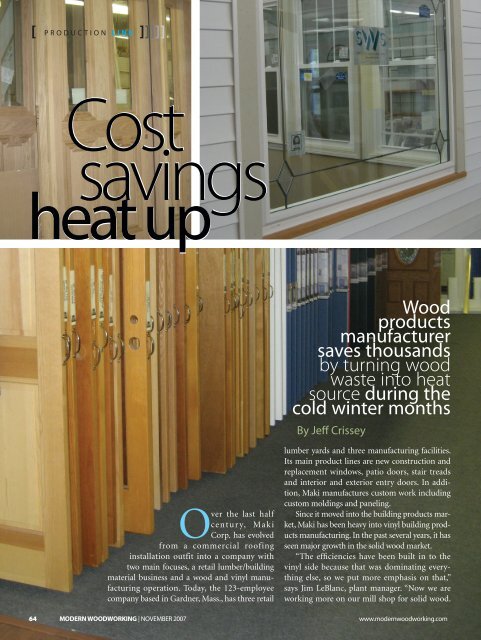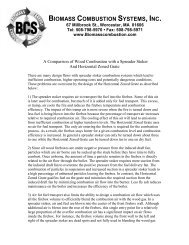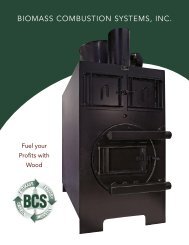Maki Corporation (PDF) - Biomass Combustion Systems, Inc.
Maki Corporation (PDF) - Biomass Combustion Systems, Inc.
Maki Corporation (PDF) - Biomass Combustion Systems, Inc.
You also want an ePaper? Increase the reach of your titles
YUMPU automatically turns print PDFs into web optimized ePapers that Google loves.
[ production line ]]]]]<br />
Cost<br />
savings<br />
heat up<br />
Wood<br />
products<br />
manufacturer<br />
saves thousands<br />
by turning wood<br />
waste into heat<br />
source during the<br />
cold winter months<br />
By Jeff Crissey<br />
O<br />
ver the last half<br />
centur y, <strong>Maki</strong><br />
Corp. has evolved<br />
from a commercial roofing<br />
installation outfit into a company with<br />
two main focuses, a retail lumber/building<br />
material business and a wood and vinyl manufacturing<br />
operation. Today, the 123-employee<br />
company based in Gardner, Mass., has three retail<br />
lumber yards and three manufacturing facilities.<br />
Its main product lines are new construction and<br />
replacement windows, patio doors, stair treads<br />
and interior and exterior entry doors. In addition,<br />
<strong>Maki</strong> manufactures custom work including<br />
custom moldings and paneling.<br />
Since it moved into the building products market,<br />
<strong>Maki</strong> has been heavy into vinyl building products<br />
manufacturing. In the past several years, it has<br />
seen major growth in the solid wood market.<br />
“The efficiencies have been built in to the<br />
vinyl side because that was dominating everything<br />
else, so we put more emphasis on that,”<br />
says Jim LeBlanc, plant manager. “Now we are<br />
working more on our mill shop for solid wood.<br />
64 Modern Woodworking | November 2007 www.modernwoodworking.com
Project2:Layout 1 8/30/07 9:07 AM Page 1<br />
WOODWORKING SYSTEM<br />
Simple to use<br />
Computer<br />
Controlled<br />
Carving Machine<br />
<br />
<br />
<br />
<br />
<br />
<br />
<br />
<br />
<br />
<br />
www.carvewright.com/mww<br />
or call us at 713-473-6572<br />
Circle 249 on Reader Service Card<br />
[ production line ]]]]]<br />
We bought a new six-head SCMI<br />
moulder to help speed up production<br />
of our beaded moldings, and we also<br />
purchased a Raimann straight-line<br />
gang rip saw. We have also added bed<br />
sanders, planers, single-head moulders<br />
and rosette machines.<br />
“If somebody wants a custom door<br />
header, we can mill that out and make<br />
our own fluted trim. We also do specialty<br />
work such as fireplace mantels.<br />
We’ve even done things for customers<br />
as small as oak bases for model boats.<br />
We have all the equipment here, so we<br />
can do just about anything.”<br />
Turning waste into profit<br />
<strong>Maki</strong> strives to make the best use of its<br />
raw materials in its production facilities,<br />
including the recycling of waste<br />
in ways that will add to the company’s<br />
bottom line. Vinyl shavings and<br />
scrap are collected in bins, which an<br />
outside company pays for and then<br />
regrinds and extrudes it to make new<br />
vinyl components. Scrap cardboard is<br />
also compacted and banded and then<br />
hauled to a recycling center.<br />
Between its lumber milling, stock<br />
millwork and custom orders, <strong>Maki</strong>’s<br />
mill shop generates a good deal of<br />
wood waste, and it has also found a<br />
way to make use of its wood residue<br />
and offal. The company purchased the<br />
first of four 800,000 BTU/hour furnaces<br />
from <strong>Biomass</strong> <strong>Combustion</strong> <strong>Systems</strong><br />
in 1999 to heat its 30,000-sq. ft.<br />
vinyl window facility, then added three<br />
more as the primary heating sources<br />
for other buildings, including the door<br />
shop and mill shop. The furnaces meet<br />
federal EPA emission standards, a requisite<br />
for <strong>Maki</strong> since it is located near<br />
a residential area. Each furnace burns<br />
120 pounds of wood per hour and can<br />
burn both green and dry wood waste.<br />
“A lot of the wood that we have<br />
winds up as waste, and throwing it<br />
in the dumpster over and over is like<br />
throwing money away,” says LeBlanc.<br />
“It makes more sense for us to save<br />
the waste, burn it and generate heat<br />
for the buildings. We constantly get<br />
packaging and hardwood pallets from<br />
the building center that we couldn’t<br />
do anything with except throw it away.<br />
Now we cut it up and save it, and we’ll<br />
start burning it in the winter.<br />
“As far as reusing waste in our mill<br />
shop production, we take full logs and<br />
slice them into boards before kilndrying<br />
them. We cut off bark edges<br />
and any other lumber defects that we<br />
process – such as knots, cracks and<br />
checks – and store those in bins for<br />
later burning.” The company commonly<br />
uses waste from pine and oak<br />
door jambs, mill shed pine, oak stair<br />
treads and casings as fuel sources.<br />
<strong>Maki</strong>’s cost savings for turning its<br />
wood waste into a heat source has<br />
been significant considering the company<br />
requires heat from late October<br />
through early April.<br />
“If it’s really cold, we’ll turn the<br />
auxiliary heat for an hour while we<br />
fire up the furnaces, then we’ll shut<br />
off the auxiliary heat for the rest of<br />
the day,” says LeBlanc. “Without the<br />
stoves, we’d be using the auxiliary<br />
heat nine hours every day and paying<br />
those heating costs. It’s hard to imagine<br />
how much our cost for fuel would<br />
be if we didn’t use wood energy.”<br />
Prior to adding the wood burning<br />
furnaces, <strong>Maki</strong> disposed of its<br />
wood waste in dumpsters, then paid<br />
a $158 disposal fee and $98 per ton to<br />
a dumpster company every week to<br />
remove its wood waste.<br />
“When you consider the fees to<br />
dispose of our wood waste and the<br />
cost of the fuel that we’d otherwise<br />
be burning, the return on investment<br />
is very quick by reusing waste from<br />
wood products.”<br />
For more information, circle:<br />
#425 for SCM Group USA;<br />
#426 for Raimann; and #427 for<br />
<strong>Biomass</strong> <strong>Combustion</strong> <strong>Systems</strong> on<br />
the Reader Service Card.<br />
66 Modern Woodworking | November 2007 www.modernwoodworking.com




